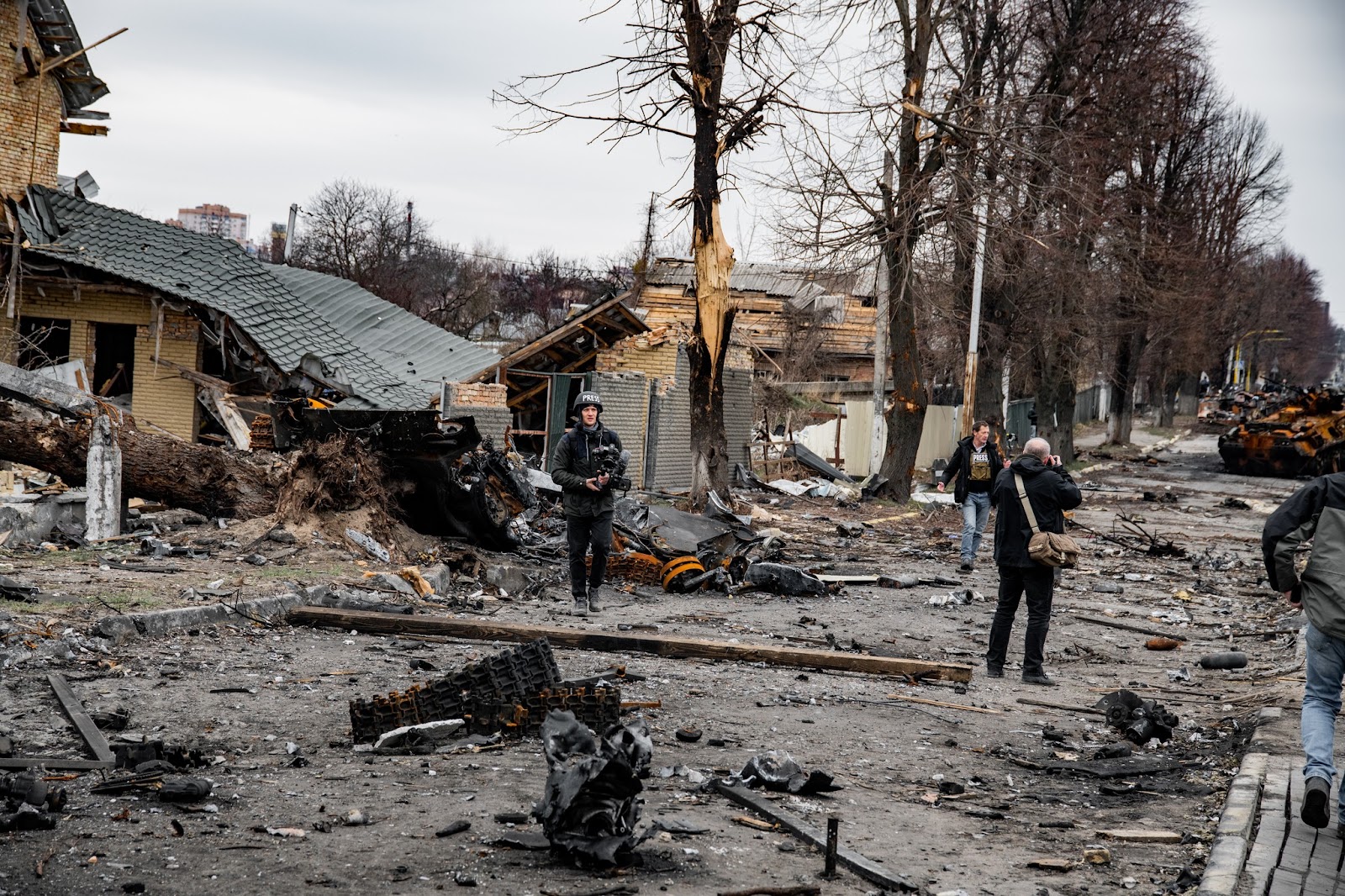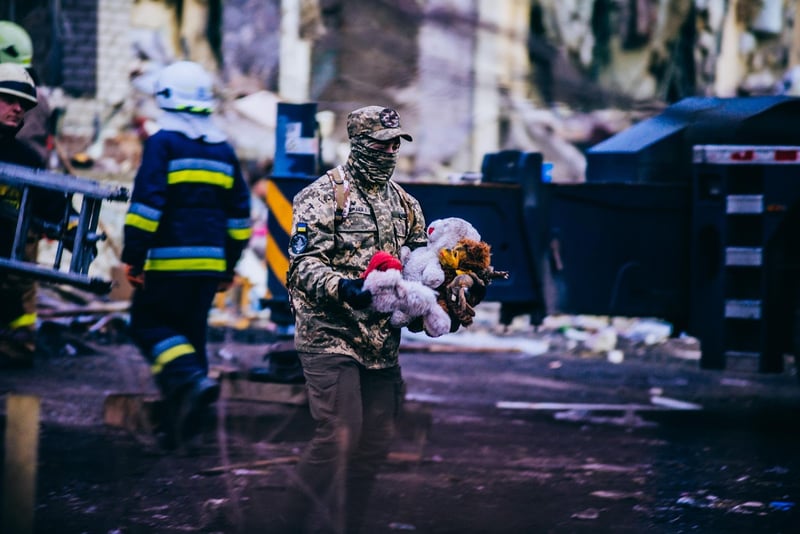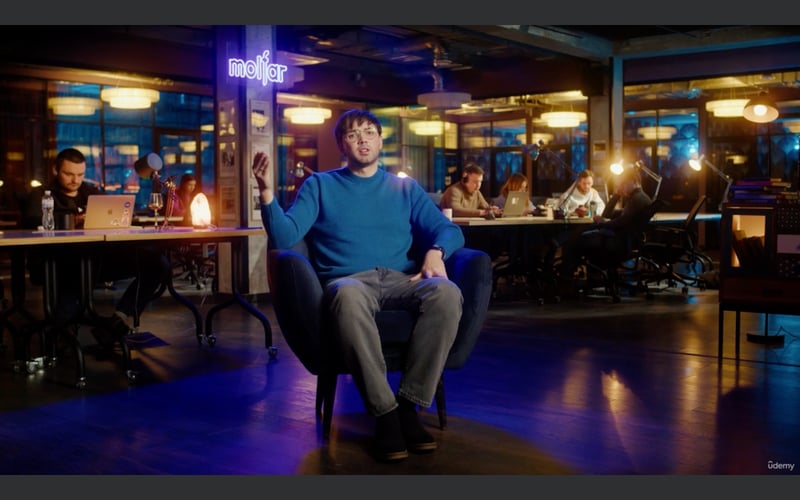By: iryna hnatiuk
February 22 2024
Two years at the frontline: How journalists and fact-checkers work in Ukraine

Source: Alex Zakletsky
February 24 will mark the second year of the Russian invasion — a grim milestone that reflects the toll it has exacted. Amid the physical battles, it's a struggle fought on the digital frontlines, earning it the titles of the first-ever social media war, the first TikTok conflict, or the most viral war in history. This is the conflict broadcast by bloggers and social media influencers and narrated with a mix of personal insights and diverse viewpoints.
Ukrainian journalists, fact-checkers, OSINT experts, and photographers are at the core of this digital battlefield, committed to telling the world what is happening on the ground, free from the distortions of misinformation. Logically Facts has spoken with some of these experts to understand their challenges and what it means for them to report on the conflict in their own country during this time.
The changing landscape of war reporting
The morning of February 24, 2022, altered the journalism landscape in Ukraine. Reporters now navigate unprecedented challenges and bear greater responsibilities, embracing new technologies, utilizing social media, and often risking their lives to deliver ground reports.
Reporters Without Borders notes that the past two years have seen over a hundred journalists subjected to violence. Of these, at least 69 media professionals, including 11 reporters, have been killed in the line of duty. Numerous others have faced bombardments in their offices, have been injured, or disappeared. Media organizations and NPOs worldwide have responded to this by offering conflict zone training, protective gear, and mental health support.
Max Levin, a Ukranian journalist killed after Russia invaded Ukraine in February 2022. (Source: Stanislav Kozliuk/Reuters)
The adversity has fostered a profound sense of unity among journalists, with international networks extending support to their Ukrainian peers. This solidarity has transformed local media workers into a cohesive force committed to accurately depicting the situation. Kateryna Sergatskova, a seasoned war correspondent and co-founder of the independent newsroom Zaborona, emphasizes the importance of supporting journalists new to war coverage. "It was important for us to support other journalists who had never reported from a war zone before," she says. Sergaskova, hailing from Crimea, and her husband, Roman Stepanovych, from Donetsk, both became war correspondents due to the conflict in their hometowns.
Covering war in one's country poses immense emotional challenges, blending personal experiences with professional duties, as Anna Fil-Pshemyska, a Ukrainian DW correspondent, noted in her interview with Kyiv Post. "One of the hardest things that every Ukrainian journalist faces is combining personal experience with work. However, being objective is still important. Even when I experienced missile strikes and when my family lived under occupation. It's hard, but it makes us tougher," says Anna.
Yulia Kochetova, a documentary filmmaker and photographer, echoes this sentiment, "To photograph, write, and talk about this war is a personal story. I know the local language and the context, but it hurts me dozens of times harder than others. I would like to get tired and take a break so much, but we do not have such a luxury. This is our war, and we must do our job."

Photo from the series We Will Never Come Back From This War by Yulia Kochetova. (Source: Yulia Kochetova)
In the chaos of conflict, fact-checking organizations have risen as pivotal players. Ukrainian media outlets have increasingly incorporated fact-checking units and OSINT methodologies into their reporting processes. For example, AFP and APA digital investigation experts have trained a group of journalists from the Ukrainian news agency Ukrinform and helped them start producing their own fact-checks immediately.
Before the war, several independent fact-checking organizations like VoxUkraine, StopFake, and BezBrekhni (Without Lie) were already operating in Ukraine. New initiatives, like Gvara, now a member of the International Fact-Checking Network (IFCN), started emerging immediately after the outbreak of the full-scale war. Initially created in response to the disinformation campaign surrounding the annexation of Crimea in 2014 and the conflict in the Eastern part of Ukraine, StopFake has become one of the most prominent fact-checking organizations in the country, now providing fact-checks in 14 languages.
The new working environment brought new challenges for Ukrainian fact-checkers, stemming from the nature of the conflict and the broader informational ecosystem in which these organizations work.
The war has led to an explosion of misinformation and propaganda, much of it deliberately disseminated to sow confusion, fear, and discord. The sheer scale of the information warfare complicates the fact-checker's mission to provide accurate and timely verifications.
"In this war, Russia has employed many digital technologies for disinformation: deepfakes, voice forgery, and manipulation with facial identification. A fact-checker must be able to deal with all this and deal quickly," says Viktoriya Romanyuk, Deputy Chief Editor and co-founder of StopFake.
Oleksandr Horokhovskyi, the founder of the anti-disinformation project BezBrekhni, adds, "For us, these are fakes, but for them [Russians], these are news."
Recently, StopFake has exposed manipulations involving prominent media outlets, and misinformation related to the aid provided to Ukraine by Western partners, and issues concerning the mobilization process.
Challenges fact-checkers face in a war zone
War severely complicates accessing reliable information with communication breakdowns and operational chaos in active conflict zones. Fact-checkers often rely on open-source intelligence (OSINT) techniques to geolocate images and footage or identify machinery, for example. While powerful, these techniques require significant expertise and resources to yield accurate results.
Wartime restrictions are another common cause of investigation delays. Journalists can collect information at the site of combat operations immediately after the shelling. However, the publication of these photos and videos is only allowed after 12 hours for military targets and after 3 hours for civilian targets. It's impossible to immediately debunk fakes and misinformation that appear and spread during this time.
Numerous blind spots in reporting appear due to the impossibility of accessing information from territories under occupation, and reaching out to people there might put them at risk.
Fact-checkers navigate risks from cyberattacks to legal harassment, threats that underscore the importance of securing their safety. Daria Verbytska from Molfar, an OSINT agency with an office in Kyiv, cites legal harassment as a recurring challenge.
The work also presents immense psychological demands. Debunking narratives that often involve casualties, atrocities, and human suffering can lead to burnout and mental health issues. Clara Jiménez Cruz, the co-founder and CEO of Maldita.es, a Spanish nonprofit fact-checking organization, says, "This war is putting a lot of pressure on fact-checkers. It is tough for any journalist to work with war imagery. But it's especially hard for fact-checkers, who have to spend eight hours straight watching terrible footage to fact-check it. We are talking about the kind of footage a producer would not air on TV."
Working within a country at war means navigating a complex legal landscape that can impose censorship and restrictions on press freedom in the name of national security. Fact-checkers must balance their commitment to truth with the need to comply with laws that might limit their ability to report freely and timely.
The Geneva Conventions explicitly prohibit the distribution of images or identification details of prisoners of war to protect their dignity and rights. However, this principle is challenged when one side in a conflict disregards these norms. Journalists and fact-checkers then face a moral and professional quandary: how to report these violations or debunk false narratives involving prisoners without further infringing on their rights by sharing prohibited content.
Journalists Vasyl Bidun and Valeriya Yegoshina underscore the strain of dealing with the psychological trauma inflicted by military atrocities. Inna Biletska, an investigative journalist, agrees and stresses the ethical considerations in reporting, prioritizing the well-being of war victims over the story. "Usually, we give people time, the right to refuse, the right to interrupt the interview, to postpone filming, not to want to answer. I would rather refuse the topic than make it worse for the person," she says.
OSINT: Intelligence in the digital era
OSINT agencies have redefined the intelligence landscape, proving indispensable in the modern war. Daria Verbytska, a spokesperson for Ukraine's premier OSINT organization, Molfar, reveals the surge in interest in learning this discipline, "In 2022, 1,200 students completed our training programs. That number has tripled in 2023, not counting those enrolled in our Udemy course." Molfar extends its educational reach by offering specialized training to Ukrainian state agencies and plans to launch an online Military OSINT course.

In their course, Molfar specialists share knowledge on working with the main OSINT tools and techniques. (Source: Udemy, screenshot)
The agency has operated since 2019, but the conflict escalation in 2022 catalyzed Molfar to assemble a volunteer force, initially lacking in qualifications but rich in enthusiasm. These volunteers, now numbering around 200, contribute to various projects. Molfar's initiative is part of a broader trend of volunteer engagement, exemplified by the Brama (The Gate) project, which has processed over 140,000 dubious links submitted by volunteers, culminating in the blockade of over 26,000 sources of disinformation since its inception.
Verbytska highlights the evolving threats faced by OSINT professionals, particularly from Russian nationals, posing significant risks to both their emotional well-being and physical safety. Moreover, the challenge of gaining international media attention for their findings has intensified. "Initially, a pitched story would quickly go viral. Now, expectations have shifted, demanding investigations to be even more compelling or contentious," Verbytska notes, underscoring the escalating standards for impactful journalism.
Through the lens: The vital role of photo correspondents in war
In the theatre of war, photographers embark on a critical mission: to capture the essence of conflict, offering the world a glimpse into realities that words can scarcely describe. Serving as a stark reminder of the human cost of war, they contribute to a collective memory. The emotional burden these photographers bear is immense as they witness and document the suffering and destruction first-hand.
Yet, their commitment to showcasing the truth and capturing the faces behind the statistics drives them to continue, often risking their lives to catch a single moment that tells a story of a thousand words. Such storytelling has been instrumental in garnering international sympathy and support.
Efrem Lukatsky, a renowned Ukrainian photojournalist who has worked with the Associated Press since 1989, shares insights from his extensive experience covering conflicts, including Chechnya, Afghanistan, Transnistria, Iraq, and the Gaza Strip. He observes how the current conflict in Ukraine has introduced new restrictions for journalists, complicating their ability to report from the heart of the action. "Previously, journalists had the chance to film right at the frontline, providing the public with a closer view of the conditions and challenges faced by soldiers and civilians alike. Now, the dynamics have shifted, particularly with the advent of drone warfare, making such access increasingly difficult and dangerous for journalists and military personnel," Lukatsky reflects.
He further notes the evolving source of war information, "Not all media outlets can now afford to send high-class journalists to a warzone. Thus, bloggers and social media have become the source of news. This means more work for fact-checkers". Lukatsky calls the conflict in Ukraine "the first war in real-time" and highlights photographers' profound responsibility in armed conflict — balancing the need to inform against the imperative to respect the dignity of their subjects, especially in their most vulnerable moments.
One poignant example is Evgeniy Maloletka's World Press Photo-winning photograph of a pregnant woman being evacuated from a bombed maternity hospital in Mariupol. While deeply distressing, the photograph was handled carefully to respect the woman's dignity, focusing on the broader tragedy rather than exploiting her pain.
Emergency workers and volunteers carry an injured pregnant woman from a maternity hospital that was damaged by shelling in Mariupol on March 9. (Source: Evgeniy Maloletka Photography)
Recalling all the armed conflicts he's seen through his camera's lenses, Lukatsky concludes that verification and fact-checking will always be one of the key tasks in such conditions. "I've personally seen people filming 'murders' in a conflict zone. And recently, I've seen a post on Facebook with text saying it was a destroyed Ukrainian city accompanied with an image from "The Pianist" movie shared thousands of times," he says.
Efrem Lukatsky. (Source: Alex Zakletsky's Facebook page)
The Russian invasion of Ukraine has prominently highlighted the critical importance of accurate information during times of unrest. It showcases the essential roles that correspondents, fact-checkers, and photographers play in documenting events, ensuring that the reality of war is communicated with clarity and precision. Their work also emphasizes the challenges inherent in reporting from such environments. They face physical, digital, and psychological risks, highlighting the need for robust support mechanisms to ensure their safety and well-being.
Angie Drobnic Holan, the director of the IFCN, explains, “We've seen that fact-checking in the war has been absolutely critical in slowing the flow of misinformation, especially for audiences that are seeking to understand the conflict through a factual rather than an ideological lens. The benefits of fact-checking have been concentrated in Ukraine and its close neighbors, but it also benefits everyone around the world who is witnessing the war or has concerns about Russia's political power and reach.”
As we reflect on the impact of the contributions of correspondents and fact-checkers, it becomes clear that the resilience and determination of these professionals are vital in maintaining the flow of factual information, which is the cornerstone of informed public discourse and decision-making. Drobnic emphasizes, "It's vitally important that this work continues because we have clearly seen that actual warfare is accompanied by informational warfare. False information can be harmful and have serious repercussions."


